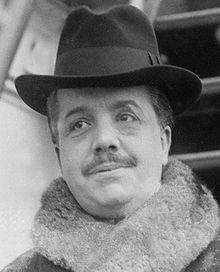Mercure (ballet)
[5] In late 1923, he rented the La Cigale music hall in Montmartre, hired former Diaghilev associate Massine as his choreographer and commissioned an eclectic group of dance and dramatic pieces utilizing the talents of authors Cocteau and Tristan Tzara, composers Milhaud and Henri Sauguet, artists Georges Braque, André Derain, and Marie Laurencin, and pioneer lighting designer Loie Fuller.
[6] Beaumont's biggest coup was reuniting Massine with Picasso and Satie for their first stage collaboration since the scandalous, revolutionary Diaghilev ballet Parade (1917), and their work was anticipated as a highlight of the Soirées' inaugural season.
In a letter to Picasso dated February 21, 1924, Beaumont stated he wanted the ballet to be a series of tableaux vivants on a mythological theme, in a lighthearted manner suitable for a music hall.
[9][10] In early 1924, just before creative talks for the Beaumont ballet got underway, Satie accused Cocteau of corrupting the morals of his onetime musical protégés Georges Auric and Francis Poulenc and severed ties with all three of them.
[11] He made the break public in an article for Paris-Journal (February 15, 1924), in which he castigated Cocteau and referred to recent ballets by Auric and Poulenc as "lots of syrupy things...buckets of musical lemonade.
[4] He invariably attended costume balls (including Beaumont's) dressed as the deity, with silver tights, winged helmet and sandals, brandishing Mercury's wand as he darted among the other guests.
[18][3][19] The drop curtain he designed featured patches of muted color (earth tones and pastel shades of blue, white and red) suggesting forms and landscape, over which the figures of a guitar-playing Harlequin and Pierrot with a violin were sinuously outlined in black.
The three-headed Cerberus was depicted on a circular shield beneath which only the dancer's feet were visible, and Massine described how the Three Graces were transformed into amorphous flats "with plaited necks like telephone extension wires which stretched and contracted as their heads bobbed up and down.
He had produced little since his orchestral dance suite La belle excentrique (1921), but his role as "precursor" to Debussy and Ravel was acknowledged, as was his advocacy of young French composers (Les Six and the "Arcueil School").
The March 1924 edition of La Revue musicale contained several laudatory articles about him, and that same month, he traveled to Belgium to give lectures on his music in Brussels and Antwerp.
[24] Beaumont trusted him implicitly and his influence pervaded the Soirées de Paris: most of its leading artists were Satie's friends or disciples, including 25-year-old music director Désormière, whose first important engagement this was.
"[28] Satie evoked a music hall spirit by employing naïve-sounding themes (though their harmonies are not) and popular forms (march, waltz, polka), and in the occasional self-consciously "humorous" scoring.
Constant Lambert believed the best example of Mercure's abstract quality was the penultimate number Le chaos, "a skillful blending of two previously heard movements, one the suave and sustained Nouvelle danse, the other the robust and snappy Polka des lettres.
These two tunes are so disparate in mood that the effect, mentally speaking, is one of complete chaos; yet it is achieved by strictly musical and even academic means which consolidate the formal cohesion of the ballet as a whole.
[30] With two other substantial ballets (Milhaud's Salade and the Strauss adaptation Le Beau Danube) and several short divertissements to stage for the Soirées, Massine urged Satie to finish the music as quickly as possible.
The fact that Satie borrowed an unpublished composition from his Schola Cantorum days, the Fugue-Valse (c. 1906), for the Danse de tendresse in Tableau I suggests he was indeed rushed by Massine.
[citation needed] One of Beaumont's objectives for the Soirées de Paris was to provide a comeback vehicle for Massine, who had been experiencing career difficulties since his acrimonious split from Diaghilev in 1921.
[37] Regarding the choreography, Massine noted, "As Mercury I had a series of adventures – intervening in the affairs of Apollo, directing the signs of the Zodiac, arranging the rape of Proserpine – each of which had to be clearly differentiated in order to strengthen the comic and dramatic content of the ballet.
"[20] A review of a later production suggests that among the dancers he alone kept in constant motion: "Through this series of plastic poses flew Mercury, a vivid figure in white tunic and scarlet coat, enthusiastically danced by Massine.
"[39] The episodes and characters were loosely drawn from Roman and Greek mythology, except for the figures of Polichinelle (from Italian Commedia dell'arte) and the Philosopher in Tableau III.
[52] The Surrealists seized on this indifference to write a "Tribute to Picasso", published in the June 20 issue of Paris-Journal and subsequently reprinted in several periodicals:[citation needed] It was signed by Breton and 14 other artists and writers, including Aragon, Max Ernst, and Philippe Soupault.
Renegade Dadaist Francis Picabia ridiculed this homage with a quip comparing Picasso's "troubling modernity" to the outdated fashions of designer Paul Poiret, causing Aragon to counter with his own statement: "I think that nothing stronger than this ballet has ever been presented in the theatre.
[66] On June 29, Satie reported this to Rolf de Maré: "The Cigale (Beaumont) has closed its doors...This poor Count – who is, after all, a good man – instead of compliments has only received insults and other nice things... That's life!
[68] Mercure was Picasso's last major work for the theatre,[69] bringing to a close a momentous period of involvement in the ballet world that had begun with Parade eight years earlier.
[72] Mercure set in motion a critical backlash against Satie that would reach fever pitch with the premiere of the Dadaist Relâche in December 1924, and was hardly quelled by his death eight months later.
The irreverence and perceived flippancy of these last two ballets galvanized his enemies and disillusioned many supporters who had championed him as a serious composer, with long-term negative effects on his posthumous reputation.
The Times reviewer thought Satie's music and Picasso's "ridiculous contraptions" were outmoded,[80] while dance historian and critic Cyril Beaumont wrote, "The whole thing appeared incredibly stupid, vulgar, and pointless.
[83] Constant Lambert revived Ashton's production for the Camargo Society at the Savoy Theatre in London on June 27, 1932, with Walter Gore and Alicia Markova as Mercury and Venus (renamed Terpsichore).
[citation needed] In 1980, composer Harrison Birtwistle published his own instrumental arrangement of Mercure, echoing a long-held (and disputed) opinion that Satie lacked skill as an orchestrator.
Among them are renditions by conductors Maurice Abravanel (Vanguard, 1968), Pierre Dervaux (EMI, 1972), Bernard Herrmann (Decca, 1973), Ronald Corp (Musical Heritage Society, 1993, reissued by Hyperion in 2004), and Jérôme Kaltenbach (Naxos, 1999).











